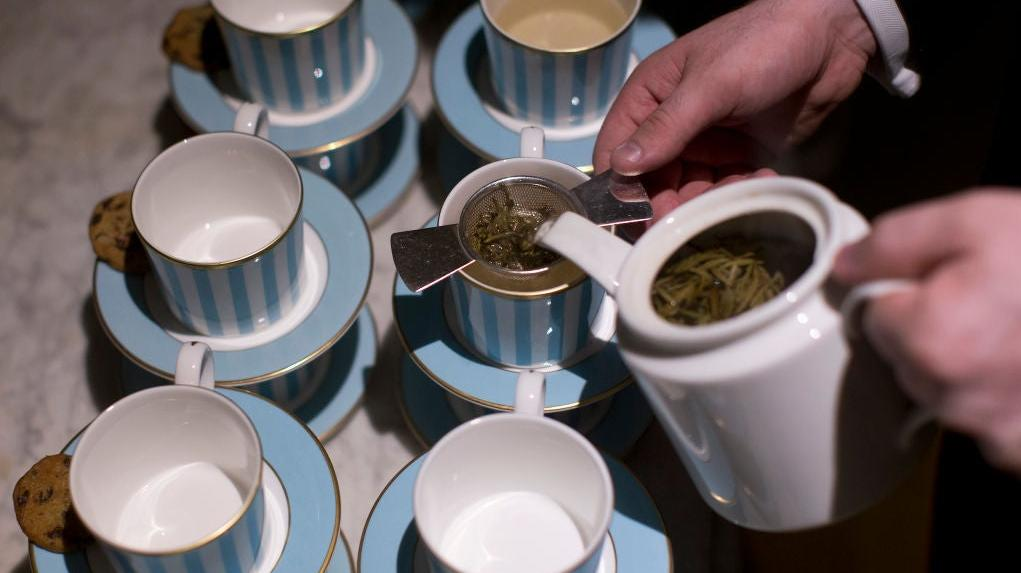How To Pour The Perfect Cup Of Tea
Tea-brewing practices vary widely based on who you ask. Here are the fundamentals.
I'll admit it: My tea know-how leaves something to be desired. I've gleaned tea-pouring tidbits from two sources: this sexually charged video of Benedict Cumberbatch, and an ill-fated green tea tasting I attended in San Francisco that left me overcaffeinated and quivering. But I've always admired the precision that goes into making a proper cuppa. With that in mind, I reached out to a few experts to ask: How does one brew the perfect cup of tea? Of course, there are enormous cultural and ceremonial differences in tea-pouring depending on your region of the world. But if you're a relative beginner like me, these tips will get you a lot closer to the perfect cup.
Hard water is your enemy
"If your tap water is hard, don't use it to make tea. The hard minerals—calcium, chlorine, and other impurities—will destroy the flavor of your tea."—Shaun Rajah, director of social catering, The Langham Chicago
"Fundamentally, hard water rich with minerals has less chemical 'space' to accept the constituents inside tea, and so harder water will extract tea poorly (usually resulting in a thin or weak cup). On the other hand, soft water (distilled being the extreme example) will extract everything a tea has to offer (resulting in a cup we would think of as over-extracted; bitter, tannic, etc.). Every tea has a different chemical makeup, and so should theoretically have an ideally mineralized water to suit that—but because we can't know every tea's chemical makeup, we shoot for consistency based on what we know about tea. That is: medium-soft water is best, preferably remineralized according to this recipe by our friend Rie."—Logan Hayes, tea buyer, Hugo Tea
Protect your leaves
"Don't use a tea bag that's been left out more than three hours. Leaving the tea bag in the open air causes a chemical reaction in the tea which lowers its quality."—Shaun Rajah, director of social catering, The Langham Chicago
Think carefully about temperature
"Brewing temperatures and steeping times vary depending on the type of tea. Lighter teas like white and green teas are best brewed at lower temperatures, 170 to 185 degrees F, while darker teas like oolong and black teas properly brew at 185 to 195 degrees. Lighter teas steep for shorter times, two to three minutes, while darker teas can be brewed for three to five minutes."—Byron Goo, co-founder, Tea Chest Hawaii
"To accurately gauge the temperature you should use for any given tea, first identify its oxidation level. This is where the categories you may be familiar with come in—green (0% oxidation), white (2-10%), oolong (15-85%), black (85-100%), etc. In general, the lower oxidation, the lower the temperature you'll want to use. That said, tea steeping is never a rigid thing, and the rules are made to be broken."—Logan Hayes, tea buyer, Hugo tea
For high-quality tea, use high-quality equipment
"It's not the pouring technique as much as it is the tea wares used to steep the teas that simply pour differently. For instance, most Japanese teas are best suited to steeping in a kyusu. Those usually are equipped with a handle perpendicular to the teapot spout, and are poured to the side. This is basically different than, say, pouring from a gaiwan, where the bowl and lid are manipulated by hand to filter the tea leaves. So again, more important than the physical technique are the 'ingredients' in your tea steeping."—Logan Hayes, tea buyer, Hugo tea
Do I need to pour the water directly onto the bag?
"A little agitation doesn't hurt when it comes to tea leaves. Less so for people."—Byron Goo, co-founder, Tea Chest Hawaii
"The way you introduce water to a tea does theoretically influence the extraction, but not enough to matter. Especially not if you're using a tea bag, where the goal is (probably) to get a single, full extraction. A cuppa. That said, there are niche thoughts on this among 'teaheads' (really dedicated tea nerds). Some teas like Taiping Houkui are routinely brewed in highball glasses, with water poured along the sides of the glass (like pouring a beer). Teas with delicate physical construction (like Japanese greens) you maybe wouldn't want to pour super aggressively into, but even then, the other variables of extraction are much more important."—Logan Hayes, tea buyer, Hugo tea
Add milk last
"In the earlier days, people will add milk to the tea cup first as prevents the cup from cracking due to the heat. Times have changed, and chinaware these days is made to hold hot beverages. I recommend [putting the] milk in last as it [impacts] the strength of the tea."—Shaun Rajah, director of social catering, The Langham Chicago
